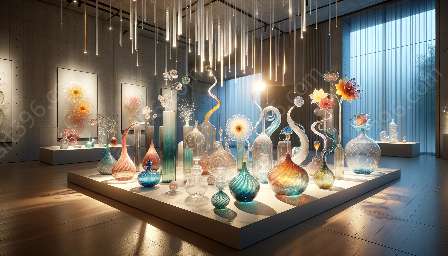Glassmaking techniques have evolved significantly over time, with traditional methods giving way to contemporary innovations. In this comparative study of glassmaking techniques, we explore the key differences between traditional and contemporary approaches, and how these changes have impacted the art of creating glass art.
Historical Overview
Traditional Glassmaking Techniques: Historically, glassmaking was a labor-intensive craft that relied on skilled artisans to heat and shape molten glass using traditional methods such as blowing, casting, and cutting. These techniques have been passed down through generations and valued for their time-honored craftsmanship.
Contemporary Glassmaking Techniques: In contrast, contemporary glassmaking techniques incorporate modern technologies and materials, enabling artists to experiment with new forms, textures, and colors. Innovations such as kiln-formed glass, glass fusing, and 3D printing have revolutionized the way glass art is created and perceived.
Technical Differences
Traditional Techniques: Traditional glassmaking often involves handcrafted processes, such as blowing glass into molds or shaping it on a blowpipe. These techniques require immense skill and precision, resulting in unique and bespoke pieces that reflect the artisan's expertise.
Contemporary Techniques: Modern glassmaking techniques leverage advanced equipment and automated processes to achieve complex designs and intricate details with greater efficiency. CNC machining, laser cutting, and digital design software have expanded the possibilities for artists to translate their visions into tangible glass artwork.
Material Innovations
Traditional Materials: Traditionally, glass artists worked with soda-lime glass, a common and economical material with inherent limitations in color and transparency. While artisans have mastered the art of manipulating this material, contemporary artists have access to a wider range of glass compositions and additives with enhanced properties.
Contemporary Materials: Contemporary glassmakers can experiment with specialized glass formulations, such as borosilicate and dichroic glass, which offer increased durability, refractive qualities, and a diverse palette of colors. These materials open new avenues for creativity and expression within the medium of glass art.
Artistic Influence
Traditional Approach: Historically, traditional glassmaking techniques were deeply rooted in cultural and regional traditions, reflecting the aesthetic preferences and craftsmanship of specific eras and locales. Each piece bore the nuances and influences of its cultural context, creating a rich tapestry of traditional glass art.
Contemporary Approach: In contrast, contemporary glass art transcends traditional boundaries, drawing inspiration from global artistic movements and interdisciplinary collaborations. Artists are empowered to push the boundaries of creativity, integrating traditional craftsmanship with modern artistic concepts and societal influences.
Impact on Glass Art
The evolution from traditional to contemporary glassmaking techniques has profoundly impacted the art of glassmaking, broadening artistic horizons and enhancing the accessibility of glass art to wider audiences. As contemporary techniques continue to evolve, glass art is poised to remain a vibrant and boundary-pushing medium for artistic expression.

